معركة سخيلده (Battle of the Scheldt)
المقدمة
كانت معركة شيلدت عملية عسكرية في شمال بلجيكا وجنوب غرب هولندا وقعت خلال الحرب العالمية الثانية. في 12 سبتمبر 1944 ، تم تكليف الجيش الكندي الأول بمهمة تطهير شيلدت من المحتلين الألمان. بدأت الهجمات الأولى في 13 سبتمبر دون نجاح يذكر.
تحت قيادة الجنرال هنري دنكان جراهام (هاري) كريرار ، كان الجيش الكندي الأول ذا طابع دولي. بالإضافة إلى الفيلق الكندي الثاني (الذي شمل فرقة المشاة الكندية الثانية والثالثة والفرقة الرابعة المدرعة الكندية) ، تم أيضًا تضمين الفيلق البريطاني الأول والفرقة المدرعة البولندية الأولى في أوقات مختلفة الجنود الأمريكيين والبلجيكيين والهولنديين كوحدات. كان أول جيش كندي في شمال غرب أوروبا خلال المراحل الأخيرة من الحرب قوة جبارة ، وهو أكبر جيش كان تحت سيطرة جنرال كندي على الإطلاق. تراوحت قوة هذا الجيش من حوالي 105000 إلى 175000 جندي كندي إلى أي مكان من 200000 إلى أكثر من 450.000 عند تضمين جنود من دول أخرى.

المركبات البرمائية الجاموس تأخذ القوات عبر شيلدت في هولندا. (مكتبة ومحفوظات كندا PA-41505)
جعلت التضاريس الموحلة التي غمرتها الفيضانات ومثابرة الدفاعات الألمانية المحصنة معركة شيلدت شاقة ودموية بشكل خاص. في الواقع ، اعتبر بعض المؤرخين أن المعركة قد خاضت في أصعب ساحة معركة في الحرب العالمية الثانية. في نهاية الهجوم الذي استمر خمسة أسابيع ، أخذ الجيش الكندي الأول المنتصر 41،043 سجينًا ، لكنه تكبد 12،873 ضحية (قتلى أو جرحى أو مفقود) ، من بينهم 6367 كنديًا.
المقدمة
هبطت قوات الحلفاء ، بما في ذلك فرقة المشاة الكندية الثالثة واللواء المدرّع الكندي الثاني من الجيش الكندي الأول ، على شواطئ نورماندي بفرنسا في يوم النصر في 6 يونيو 1944. مع تقدم الجيوش إلى الداخل ، انخرط الجيش الكندي في قتال مرير في كاين وفاليز. ولكن مع قتال مئات الآلاف من القوات عبر الجبهة ، احتاج الحلفاء إلى كميات كبيرة من الإمدادات ، وتم تكليف الجيش الكندي الأول بمهمة تطهير المناطق الساحلية وفتح موانئ القناة للإمدادات الحيوية.
القتال على الجناح الأيسر لقوات الحلفاء ، اندفع الجيش الكندي الأول بسرعة باتجاه الشرق عبر فرنسا باتجاه بلجيكا. بدأ سبتمبر مع فرقة المشاة الكندية الثانية التي تم الترحيب بها في دييب. غادر الفيلق الكندي الثاني عددًا من الوحدات لحراسة الموانئ المدافعة بشدة ودفع إلى بلجيكا ، ووصل إلى أوستند وبروج وجينت بحلول منتصف الشهر. بحلول الأول من أكتوبر ، كانت مدن بولوني وكاب جريس نيز وكاليه ودونكيرك كلها تحت سيطرة الحلفاء. استولى الفيلق الكندي الثاني أيضًا على مواقع إطلاق الصواريخ الألمانية ووضع حدًا لهجماته على جنوب إنجلترا.
في غضون ذلك ، تقدم الجيش البريطاني الثاني إلى جنوب هولندا. في 17 سبتمبر ، حاولت ثلاث فرق بريطانية وأمريكية محمولة جواً ، بالإضافة إلى لواء من قوات المظلات البولندية ، الهبوط خلف خطوط العدو في نيميغن وأيندهوفن وأرنهيم. كان الهدف من المهمة هو الاستيلاء على جسر فوق نهر الراين في أرنهيم. فشلت العملية ، حيث قُتل 1400 من إجمالي القوة 35000 وأسر أكثر من 6000. بدا أن أي أمل في نهاية سريعة للحرب قد تبدد.
أصبح الاستيلاء على ميناء رئيسي أولوية قصوى حيث أصبحت خطوط الإمداد الكافية لفصل الشتاء الآن ذات أهمية قصوى. استولى الجيش البريطاني الثاني على ميناء أنتويرب وكانت منشآته سليمة تقريبًا. باعتبارها ثاني أكبر ميناء في أوروبا ، كانت أنتويرب وأرصفةها التي يبلغ طولها 45 كيلومترًا أرضًا مثالية لهبوط الإمدادات للجهود الحربية المستمرة. في الواقع ، كان افتتاح ميناء أنتويرب أمرًا ضروريًا ، حيث لا تزال خطوط الإمداد الرئيسية في هذه المرحلة تسير عائدة إلى نورماندي.

ناقلات المشاة الملكية هاملتون الخفيفة تتحرك عبر قرية كرابينديجكي الهولندية على جسر بيفيلاند ، 27 أكتوبر 1944. (مكتبة ومحفوظات كندا PA-41949)

Scheldt Embarkation Point ، غرب Terneuzen ، أكتوبر 1944. (مكتبة ومحفوظات كندا PA-41585)
ومع ذلك ، لا يزال المحتلون الألمان يسيطرون على نهر شيلدت الذي يربط ميناء أنتويرب ببحر الشمال. طالما سيطر الألمان على البحر يقترب والمصب الطويل المتعرج ، فإن شحن الحلفاء إلى الميناء سيكون مستحيلاً. لم يكن مجرد احتلال أنتويرب كافياً. يجب تحرير جميع الأراضي المحيطة بشيلدت أولاً.
معركة شيلدت
عُهد بمهمة تحرير شيلدت إلى الجيش الكندي الأول ، تحت قيادة اللفتنانت جنرال جاي سيموندز (بدلاً من الجنرال كريرار ، الذي عاد إلى إنجلترا بسبب المرض الشديد).
جعلت الجغرافيا الفريدة للمنطقة تحدي الجيش الكندي الأول أكثر صعوبة. شمال مصب النهر تقع جنوب بيفيلاند. ما وراء جنوب بيفيلاند تقع جزيرة Walcheren ، التي كانت محصنة في معقل ألماني قوي. كانت الضفة الجنوبية من المصب عبارة عن أراض فيضانات منبسطة محاطة بالسدود ، تُعرف باسم "بلد بولدر". كان تحت مستوى سطح البحر ومناسب تمامًا للدفاع.
تضمنت خطة فتح المصب أربع عمليات رئيسية. الأول كان تطهير المنطقة الواقعة شمال أنتويرب وتأمين الوصول إلى جنوب بيفيلاند. والثاني هو تنظيف جيب Breskens خلف قناة Leopold ، والثالث هو الاستيلاء على South Beveland. ستكون المرحلة الأخيرة هي الاستيلاء على جزيرة Walcheren.
في أوائل أكتوبر 1944 ، بدأت فرقة المشاة الكندية الثانية تقدمها شمال أنتويرب ، بينما بدأت فرقة المشاة الكندية الثالثة ، بدعم من الفرقة الرابعة المدرعة الكندية ، الهجوم على قناة ليوبولد. كان القتال شرسًا في كلا المنطقتين. جعلت القوات الألمانية الراسخة من الصعب على قوات الحلفاء التقدم.
تقدمت فرقة المشاة الكندية الثانية شمالًا لإغلاق الطرف الشرقي لجنوب بيفيلاند ، وحققت تقدمًا جيدًا ضد المظليين الأعداء الذين كانوا يعرقلون الطريق. كانت الخسائر في الأرواح كبيرة عندما هاجمت القوات الكندية على أرض غمرتها المياه المفتوحة ، لكن بحلول 16 أكتوبر / تشرين الأول ، استولوا على بلدة Woensdrecht عند مدخل جنوب بيفيلاند.
في 16 أكتوبر ، بعد شهر تقريبًا من الهجوم الجوي الفاشل في هولندا ، أمر فيلد مارشال برنارد مونتغمري ، القائد العام للجيشين الكندي الأول والثاني ، بجعل تأمين شيلدت أولوية قصوى للجيش.
في غضون ذلك ، ركز اللفتنانت جنرال سيموندس على المنطقة الواقعة شمال جنوب بيفيلاند. تحركت الفرقة المدرعة الكندية الرابعة ، التي كانت تعمل في قناة ليوبولد ، شمال شيلدت وتوجهت بقوة إلى بلدة بيرغن أوب زوم. بحلول 24 أكتوبر ، تم اختراق وتأمين المدخل إلى South Beveland وبدأت الفرقة الكندية الثانية التقدم إلى South Beveland ، بمساعدة هبوط برمائي من قبل الفرقة البريطانية 52. بحلول 31 أكتوبر ، تم تأمين المنطقة من قبل الحلفاء.

الكنديون يدخلون بيرغن-أوب-زوم. (مكتبة ومحفوظات كندا PA-42038)

عودة الكناس إلى أرصفة أنتويرب ، 26 نوفمبر 1944. (مكتبة ومحفوظات كندا PA-42887)

قرية بيرفليت في جيب بريسكينز ، أكتوبر 1944. (مكتبة ومحفوظات كندا PA-41724)
كان القتال على طول الشاطئ الجنوبي لشيلدت شرسًا بنفس القدر. هنا واجهت الفرقة الكندية الثالثة معارضة ألمانية عنيدة حيث قاتلت لعبور قناة ليوبولد وتطهير جيب بريسكينز خلف القناة. بدأ الهجوم في 6 أكتوبر ضد معارضة شرسة ، ولمدة ثلاثة أيام كان رأس الجسر النحيل في خطر دائم من القضاء عليه. أخيرًا ، في 9 أكتوبر ، كسر هجوم برمائي قبضة العدو على القناة ، وتم تعميق رأس الجسر. عبرت القوات والدبابات القناة وانسحب الألمان إلى المخابئ الخرسانية على طول الساحل. تبع ذلك مزيد من القتال ، ولكن بحلول 3 نوفمبر تم تأمين الشاطئ الجنوبي لشيلدت.
ترك هذا جزيرة Walcheren كالعقبة الأخيرة لتأمين ميناء أنتويرب لاستخدام الحلفاء. ومع ذلك ، فقد قام الألمان بتحصين موقعهم على الجزيرة وكان نهج الأرض الوحيد هو الممر الضيق الطويل من جنوب بيفيلاند. ومما زاد الطين بلة ، أن الشقق التي أحاطت بهذا الجسر كانت مشبعة بمياه البحر لدرجة لا تسمح لها بالحركة سيرًا على الأقدام ، ولكن مع القليل من الماء للهجوم في قوارب العواصف.
تعرضت الجزيرة للهجوم من ثلاثة اتجاهات: عبر الجسر من الشرق ، عبر شيلدت من الجنوب ، ومن الغرب عن طريق البحر. لإعاقة الدفاع الألماني ، تم اختراق سدود الجزيرة بقصف مكثف لسلاح الجو الملكي ، مما أدى إلى إغراق المنطقة الوسطى وسمح باستخدام المركبات البرمائية.
هاجم الكنديون الجسر في 31 أكتوبر ، وبعد صراع مكلف ، أسسوا موطئ قدم. ثم ، بالتزامن مع الهجمات التي تنقلها المياه ، واصلت الفرقة البريطانية 52 تقدمها. في 6 نوفمبر ، تم تأمين مدينة ميدلبورغ عاصمة الجزيرة ، وبحلول 8 نوفمبر انتهت كل معارضة الأعداء.
في هذه الأثناء ، كانت الفرقة المدرعة الكندية الرابعة قد توغلت شرقًا متجاوزة بيرغن أوب زوم إلى سانت فيلبس لاند حيث غرقت عدة سفن ألمانية في ميناء زيجبي.
وهكذا ، مع الطرق إلى أنتويرب الحرة وتم تطهير البلاد حتى نهر ماس ، انتهت معركة شيلدت وتم تأمين خط الإمداد الحاسم ، الضروري لتغذية تقدم الحلفاء لتحرير أوروبا. تم تطهير القناة من الألغام ، وفي 28 نوفمبر ، دخلت القافلة الأولى إلى ميناء أنتويرب ، بقيادة سفينة الشحن الكندية Fort Cataraqui.
الدعم الجوي والبحري
لم تكن الحملات في شمال غرب أوروبا لتنجح لولا دعم القوات البحرية والجوية للحلفاء. أبقت القوات البحرية على الممرات البحرية مفتوحة للذخائر والإمدادات والتعزيزات ، بينما كانت القوات الجوية تحلق فوق الأجواء وتشارك في مهام قصف خطيرة.
تذكر أضحيتهم
هؤلاء الكنديون الذين قاتلوا في معركة شيلدت حققوا وضحوا بالكثير في جهودهم للمساعدة في إحلال السلام والحرية لشعوب أوروبا. كان هؤلاء المقاتلون من بين أكثر من مليون رجل وامرأة خدموا في القوات المسلحة الكندية خلال الحرب العالمية الثانية.
ضحى أكثر من 42000 كندي بحياتهم في الحرب. تعترف كندا والعالم بتضحيات وإنجازات جميع الكنديين ، مثل أولئك الذين حاربوا في معركة شيلدت ، الذين أنجزوا الكثير وتركوا إرثًا دائمًا من السلام. تم دفن معظم الكنديين الذين ماتوا في معركة شيلدت في مقبرتين لحرب الكومنولث في المنطقة. تقع مقبرة Adegem Canadian War Cemetery في الركن الشمالي الغربي لبلجيكا ، وهي ليست بعيدة عن الحدود الهولندية. يحتوي على قبور 848 كنديًا ، معظمهم فقدوا حياتهم خلال الصراع المرير لتطهير جيب بريسكينز على الضفة الجنوبية لشيلدت.
تقع مقبرة بيرغن أوب زوم الكندية للحرب في جنوب غرب هولندا. يحتوي على قبور 968 كنديًا ، سقط معظمهم في القتال لفتح مداخل البحر إلى أنتويرب وجعل هذا الميناء متاحًا لحلفاء الشحن.

مقبرة الحرب الكندية Adegem. (شؤون المحاربين القدامى كندا)

مقبرة الحرب الكندية بيرغن أوب زوم. (شؤون المحاربين القدامى كندا)
خريطة معركة شيلدت
خريطة توضح حركة قوات الحلفاء خلال معركة شيلدت في أكتوبر ونوفمبر 1944. لعبت فرقة المشاة الكندية الثالثة والفرقة الرابعة المدرعة الكندية دورًا رائدًا في تحرير الشاطئ الجنوبي لشيلدت ، مع الفرقة المدرعة البولندية الأولى أيضا تقديم مساهمات مهمة. قاتلت فرقة المشاة الكندية الثانية شمال أنتويرب ثم غربًا لتحرير جنوب بيفيلاند وجزيرة والشيرين على الشاطئ الشمالي لشيلدت. كما شاركت الفرقة المدرعة الكندية الرابعة في تطهير المنطقة الواقعة شرق شيلدت من قوات العدو. كما ساعدت القوات البريطانية في هزيمة العدو في جنوب بيفيلاند وجزيرة والشرين ، ودفعت الألمان للتراجع في القتال شمال وشرق أنتويرب.

خريطة معركة شيلدت
.........
Introduction
The Battle of the Scheldt was a military operation in northern Belgium and the southwestern Netherlands that took place during the Second World War. On September 12, 1944, the First Canadian Army was given the task of clearing the Scheldt of German occupiers. The first attacks began on September 13, with little success.
Under the command of General Henry Duncan Graham (Harry) Crerar, the First Canadian Army was international in character. In addition to the 2nd Canadian Corps (which included the 2nd and 3rd Canadian Infantry Divisions and the 4th Canadian Armoured Division), the 1st British Corps, and the 1st Polish Armoured Division, at various times American, Belgian, and Dutch soldiers were also included as units. The First Canadian Army in northwestern Europe during the final phases of the war was a powerful force, the largest army that had ever been under the control of a Canadian general. The strength of this army ranged from approximately 105,000 to 175,000 Canadian soldiers to anywhere from 200,000 to over 450,000 when including the soldiers from other nations.
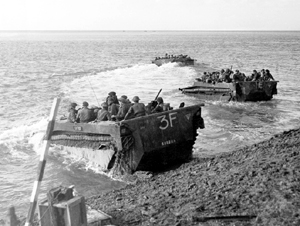
Buffalo amphibious vehicles taking troops across the Scheldt in Holland. (Library and Archives Canada PA-41505)
The flooded, muddy terrain and the tenacity of the well-fortified German defences made the Battle of the Scheldt especially gruelling and bloody. Indeed, the battle is considered by some historians to have been waged on the most difficult battlefield of the Second World War. At the end of the five-week offensive, the victorious First Canadian Army had taken 41,043 prisoners, but suffered 12,873 casualties (killed, wounded, or missing), 6,367 of whom were Canadians.
The Prelude
The Allied forces, including the 3rd Canadian Infantry Division, and the 2nd Canadian Armoured Brigade of the First Canadian Army, landed on the beaches of Normandy, France on D-Day, June 6, 1944. As the armies progressed further inland, the First Canadian Army engaged in bitter fighting at Caen and Falaise. But with hundreds of thousands of troops fighting across the front, the Allies needed large amounts of supplies, and the First Canadian Army was assigned the task of clearing the coastal areas and opening the channel ports for vital supplies.
Fighting on the left flank of the Allied forces, the First Canadian Army pushed rapidly eastward through France toward Belgium. September began with the 2nd Canadian Infantry Division being welcomed to Dieppe. The 2nd Canadian Corps left a number of units to guard the heavily defended ports and pushed into Belgium, reaching Ostend, Bruges and Ghent by the middle of the month. By October 1, the port cities of Boulogne, Cap Gris Nez, Calais, and Dunkirk were all under Allied control. The 2nd Canadian Corps had also captured the launching sites of German rockets and put an end to their attacks on southern England.
Meanwhile, the Second British Army had pushed forward into southern Netherlands. On September 17, three British and American airborne divisions, as well as a brigade of Polish parachute troops, attempted to land behind enemy lines at Nijmegen, Eindhoven and Arnhem. Code-named Operation Market Garden, the mission's objective was to seize a bridge over the Rhine River at Arnhem. The operation failed, with 1,400 of a total force of 35,000 killed and more than 6,000 taken prisoner. Any hope for a speedy end to the war appeared to be dashed.
Capturing a major port became a top priority as adequate supply lines for the winter now became paramount. The Second British Army had seized the port of Antwerp with its installations virtually intact. As Europe's second-largest port, Antwerp and its 45 kilometres of docks was an ideal landing ground for supplies for the continuing war effort. In fact, the opening of the port of Antwerp was essential, since at this point the main supply lines still ran back to Normandy.
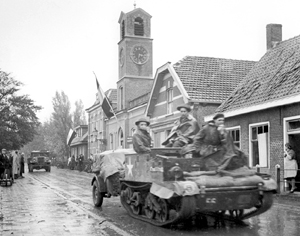
Royal Hamilton Light Infantry carriers move through the Dutch village of Krabbendijke on the Beveland Causeway, 27 October 1944. (Library and Archives Canada PA-41949)
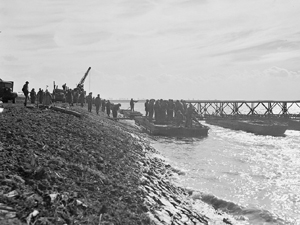
Scheldt Embarkation Point, West of Terneuzen, October 1944. (Library and Archives Canada PA-41585)
However, German occupiers still controlled the Scheldt river which connected the port of Antwerp to the North Sea. As long as the Germans held control of the sea approaches and the long winding estuary, Allied shipping to the port would be impossible. The mere occupation of Antwerp was not enough; all the lands surrounding the Scheldt would have to be liberated first.
The Battle of the Scheldt
The task of liberating the Scheldt was entrusted to the First Canadian Army, under the command of Lieutenant-General Guy Simonds (in place of General Crerar, who had returned to England because of severe illness).
The unique geography of the area made the First Canadian Army's challenge even more daunting. North of the estuary lay South Beveland. Beyond South Beveland lay the island of Walcheren, which had been fortified into a powerful German stronghold. The south bank of the estuary was flat floodlands enclosed by dykes, known as "polder country". It was below sea level and well-suited to defence.
The plan for opening the estuary involved four main operations. The first was to clear the area north of Antwerp and secure access to South Beveland. The second was to clear the Breskens pocket behind the Leopold Canal, and the third was the capture of South Beveland. The final phase would be the capture of Walcheren Island.
Early in October 1944, the 2nd Canadian Infantry Division began its advance north of Antwerp, while the 3rd Canadian Infantry Division, supported by the 4th Canadian Armoured Division, began the assault over the Leopold Canal. In both areas the fighting was fierce. The well-entrenched German forces made it difficult for the Allied Forces to advance.
The 2nd Canadian Infantry Division, advancing north to close the eastern end of South Beveland, made good progress against the enemy paratroopers who were barring the way. Casualties were heavy as Canadian troops attacked over open flooded ground, but by October 16 they had seized the town of Woensdrecht at the entrance to South Beveland.
On October 16, nearly a month after the failed airborne assault in the Netherlands, Field-Marshall Bernard Montgomery, the overall commander of the First Canadian and the Second British Armies, ordered the securing of the Scheldt be made the army's top priority.
Meanwhile, Lieutenant-General Simonds concentrated on the area north of South Beveland. The 4th Canadian Armoured Division, which had been engaged at the Leopold Canal, moved north of the Scheldt and drove hard for the town of Bergen-op-Zoom. By October 24, the entrance to South Beveland was breached and secured and the 2nd Canadian Division began the advance into South Beveland, assisted by an amphibious landing by the 52nd British Division. By October 31, the area was secured by the Allies.
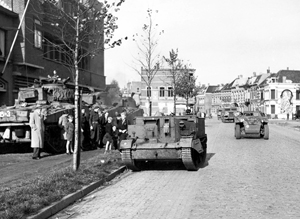
Canadians enter Bergen-op-Zoom. (Library and Archives Canada PA-42038)
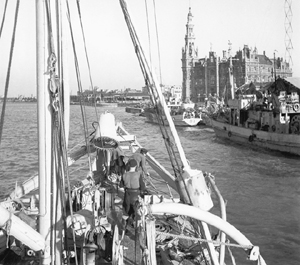
Sweepers returning to Antwerp docks, November 26, 1944. (Library and Archives Canada PA-42887)
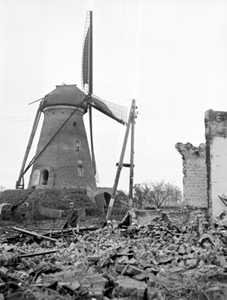
Village of Biervliet in the Breskens Pocket, October 1944. (Library and Archives Canada PA-41724)
Fighting along the Scheldt's southern shore was equally fierce. Here the 3rd Canadian Division encountered tenacious German opposition as it fought to cross the Leopold Canal and clear the Breskens pocket behind the canal. The attack began on October 6 against fierce opposition, and for three days a slender bridgehead was in constant danger of elimination. Finally, on October 9, an amphibious assault broke the enemy's hold on the canal, and the bridgehead was deepened. Troops and tanks crossed the canal and the Germans withdrew into concrete bunkers along the coast. More fighting followed, but by November 3 the south shore of the Scheldt was secured.
This left the island of Walcheren as the last obstacle to securing the port of Antwerp for Allied use. However, the Germans had fortified their position on the island and the only land approach was the long narrow causeway from South Beveland. To make matters worse, the flats that surrounded this causeway were too saturated with sea water for movement on foot but with too little water for an assault in storm boats.
The island was attacked from three directions: across the causeway from the east, across the Scheldt from the south, and from the west by sea. To hamper German defence, the island's dykes were breached by heavy Royal Air Force bombing, which flooded the central area and allowed the use of amphibious vehicles.
The Canadians attacked the causeway on October 31, and, after a costly struggle, established a foothold. Then, in conjunction with the waterborne attacks, the 52nd British Division continued the advance. On November 6, the island's capital Middelburg was secured, and by November 8 all enemy opposition ended.
Meanwhile, the 4th Canadian Armoured Division had pushed eastward past Bergen-op-Zoom to St. Philipsland where it sank several German vessels in Zijpe harbour.
Thus, with the approaches to Antwerp free and the country up to the Maas River cleared, the Battle of the Scheldt was over and the crucial supply line, essential to fuel the Allied advance to liberate Europe, was secured. The channel was cleared of mines and, on November 28, the first convoy entered the port of Antwerp, led by the Canadian-built freighter Fort Cataraqui.
Air and Sea Support
The campaigns in Northwest Europe could not have succeeded without the support of Allied naval and air forces. The navies kept open the sea lanes for munitions, supplies and reinforcements, while overhead the air forces cleared the skies, and engaged in dangerous bombing missions.
Remembering their Sacrifice
Those Canadians who fought in the Battle of the Scheldt achieved and sacrificed much in their efforts to help bring peace and freedom to the people of Europe. These combattants were among the more than one million men and women who served in Canada's Armed Forces during the Second World War.
More than 42,000 Canadians gave their lives in the war. Canada and the world recognize the sacrifices and achievements of all Canadians, like those who fought in the Battle of the Scheldt, who accomplished so much and left a lasting legacy of peace. Most of the Canadians who died in the Battle of the Scheldt are buried at two Commonwealth War Cemeteries in the region. Adegem Canadian War Cemetery is in the northwest corner of Belgium, not far from the Dutch frontier. It contains the graves of 848 Canadians, most of whom lost their lives during the bitter struggle to clear the Breskens pocket on the south bank of the Scheldt.
Bergen-op-Zoom Canadian War Cemetery is located in southwest Holland. It contains the graves of 968 Canadians, most of whom fell fighting to open the sea approaches to Antwerp and make that port available to Allied shipping.
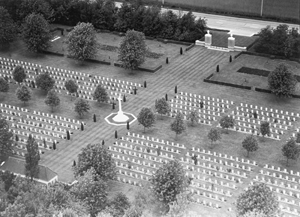
Adegem Canadian War Cemetery. (Veterans Affairs Canada)
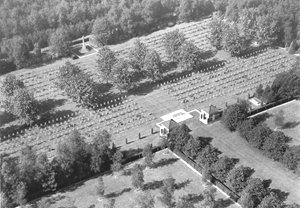
Bergen-op-Zoom Canadian War Cemetery. (Veterans Affairs Canada)
Map of the Battle of the Scheldt
Map showing the movement of Allied forces during the Battle of the Scheldt in October and November 1944. The 3rd Canadian Infantry Division and 4th Canadian Armoured Division played a leading role in the liberation of the southern shore of the Scheldt, with the 1st Polish Armoured Division also making important contributions. The 2nd Canadian Infantry Division fought north of Antwerp and then west to liberate South Beveland and Walcheren Island on the northern shore of the Scheldt. The 4th Canadian Armoured Division was also involved in clearing enemy forces from the area east of the Scheldt. British forces also helped defeat the enemy in South Beveland and Walcheren Island, and pushed the Germans back in fighting north and east of Antwerp.
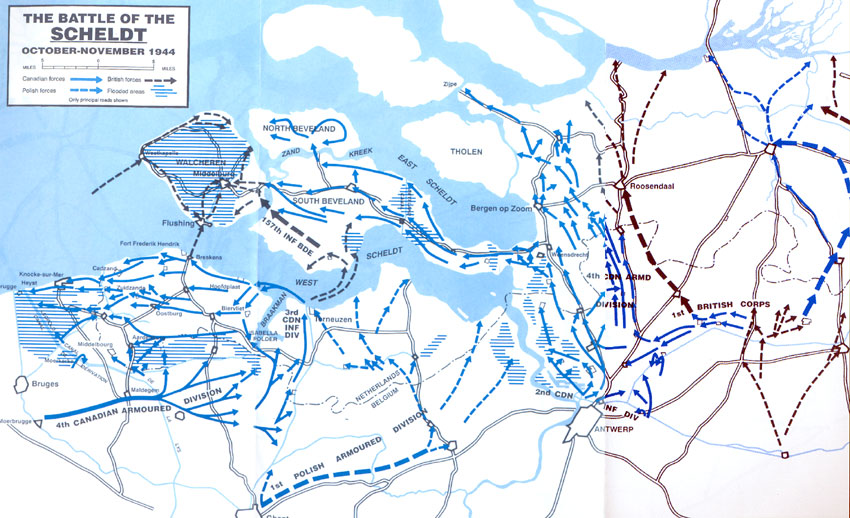
Map of the Battle of the Scheldt
المقدمة
كانت معركة شيلدت عملية عسكرية في شمال بلجيكا وجنوب غرب هولندا وقعت خلال الحرب العالمية الثانية. في 12 سبتمبر 1944 ، تم تكليف الجيش الكندي الأول بمهمة تطهير شيلدت من المحتلين الألمان. بدأت الهجمات الأولى في 13 سبتمبر دون نجاح يذكر.
تحت قيادة الجنرال هنري دنكان جراهام (هاري) كريرار ، كان الجيش الكندي الأول ذا طابع دولي. بالإضافة إلى الفيلق الكندي الثاني (الذي شمل فرقة المشاة الكندية الثانية والثالثة والفرقة الرابعة المدرعة الكندية) ، تم أيضًا تضمين الفيلق البريطاني الأول والفرقة المدرعة البولندية الأولى في أوقات مختلفة الجنود الأمريكيين والبلجيكيين والهولنديين كوحدات. كان أول جيش كندي في شمال غرب أوروبا خلال المراحل الأخيرة من الحرب قوة جبارة ، وهو أكبر جيش كان تحت سيطرة جنرال كندي على الإطلاق. تراوحت قوة هذا الجيش من حوالي 105000 إلى 175000 جندي كندي إلى أي مكان من 200000 إلى أكثر من 450.000 عند تضمين جنود من دول أخرى.

المركبات البرمائية الجاموس تأخذ القوات عبر شيلدت في هولندا. (مكتبة ومحفوظات كندا PA-41505)
جعلت التضاريس الموحلة التي غمرتها الفيضانات ومثابرة الدفاعات الألمانية المحصنة معركة شيلدت شاقة ودموية بشكل خاص. في الواقع ، اعتبر بعض المؤرخين أن المعركة قد خاضت في أصعب ساحة معركة في الحرب العالمية الثانية. في نهاية الهجوم الذي استمر خمسة أسابيع ، أخذ الجيش الكندي الأول المنتصر 41،043 سجينًا ، لكنه تكبد 12،873 ضحية (قتلى أو جرحى أو مفقود) ، من بينهم 6367 كنديًا.
المقدمة
هبطت قوات الحلفاء ، بما في ذلك فرقة المشاة الكندية الثالثة واللواء المدرّع الكندي الثاني من الجيش الكندي الأول ، على شواطئ نورماندي بفرنسا في يوم النصر في 6 يونيو 1944. مع تقدم الجيوش إلى الداخل ، انخرط الجيش الكندي في قتال مرير في كاين وفاليز. ولكن مع قتال مئات الآلاف من القوات عبر الجبهة ، احتاج الحلفاء إلى كميات كبيرة من الإمدادات ، وتم تكليف الجيش الكندي الأول بمهمة تطهير المناطق الساحلية وفتح موانئ القناة للإمدادات الحيوية.
القتال على الجناح الأيسر لقوات الحلفاء ، اندفع الجيش الكندي الأول بسرعة باتجاه الشرق عبر فرنسا باتجاه بلجيكا. بدأ سبتمبر مع فرقة المشاة الكندية الثانية التي تم الترحيب بها في دييب. غادر الفيلق الكندي الثاني عددًا من الوحدات لحراسة الموانئ المدافعة بشدة ودفع إلى بلجيكا ، ووصل إلى أوستند وبروج وجينت بحلول منتصف الشهر. بحلول الأول من أكتوبر ، كانت مدن بولوني وكاب جريس نيز وكاليه ودونكيرك كلها تحت سيطرة الحلفاء. استولى الفيلق الكندي الثاني أيضًا على مواقع إطلاق الصواريخ الألمانية ووضع حدًا لهجماته على جنوب إنجلترا.
في غضون ذلك ، تقدم الجيش البريطاني الثاني إلى جنوب هولندا. في 17 سبتمبر ، حاولت ثلاث فرق بريطانية وأمريكية محمولة جواً ، بالإضافة إلى لواء من قوات المظلات البولندية ، الهبوط خلف خطوط العدو في نيميغن وأيندهوفن وأرنهيم. كان الهدف من المهمة هو الاستيلاء على جسر فوق نهر الراين في أرنهيم. فشلت العملية ، حيث قُتل 1400 من إجمالي القوة 35000 وأسر أكثر من 6000. بدا أن أي أمل في نهاية سريعة للحرب قد تبدد.
أصبح الاستيلاء على ميناء رئيسي أولوية قصوى حيث أصبحت خطوط الإمداد الكافية لفصل الشتاء الآن ذات أهمية قصوى. استولى الجيش البريطاني الثاني على ميناء أنتويرب وكانت منشآته سليمة تقريبًا. باعتبارها ثاني أكبر ميناء في أوروبا ، كانت أنتويرب وأرصفةها التي يبلغ طولها 45 كيلومترًا أرضًا مثالية لهبوط الإمدادات للجهود الحربية المستمرة. في الواقع ، كان افتتاح ميناء أنتويرب أمرًا ضروريًا ، حيث لا تزال خطوط الإمداد الرئيسية في هذه المرحلة تسير عائدة إلى نورماندي.

ناقلات المشاة الملكية هاملتون الخفيفة تتحرك عبر قرية كرابينديجكي الهولندية على جسر بيفيلاند ، 27 أكتوبر 1944. (مكتبة ومحفوظات كندا PA-41949)

Scheldt Embarkation Point ، غرب Terneuzen ، أكتوبر 1944. (مكتبة ومحفوظات كندا PA-41585)
ومع ذلك ، لا يزال المحتلون الألمان يسيطرون على نهر شيلدت الذي يربط ميناء أنتويرب ببحر الشمال. طالما سيطر الألمان على البحر يقترب والمصب الطويل المتعرج ، فإن شحن الحلفاء إلى الميناء سيكون مستحيلاً. لم يكن مجرد احتلال أنتويرب كافياً. يجب تحرير جميع الأراضي المحيطة بشيلدت أولاً.
معركة شيلدت
عُهد بمهمة تحرير شيلدت إلى الجيش الكندي الأول ، تحت قيادة اللفتنانت جنرال جاي سيموندز (بدلاً من الجنرال كريرار ، الذي عاد إلى إنجلترا بسبب المرض الشديد).
جعلت الجغرافيا الفريدة للمنطقة تحدي الجيش الكندي الأول أكثر صعوبة. شمال مصب النهر تقع جنوب بيفيلاند. ما وراء جنوب بيفيلاند تقع جزيرة Walcheren ، التي كانت محصنة في معقل ألماني قوي. كانت الضفة الجنوبية من المصب عبارة عن أراض فيضانات منبسطة محاطة بالسدود ، تُعرف باسم "بلد بولدر". كان تحت مستوى سطح البحر ومناسب تمامًا للدفاع.
تضمنت خطة فتح المصب أربع عمليات رئيسية. الأول كان تطهير المنطقة الواقعة شمال أنتويرب وتأمين الوصول إلى جنوب بيفيلاند. والثاني هو تنظيف جيب Breskens خلف قناة Leopold ، والثالث هو الاستيلاء على South Beveland. ستكون المرحلة الأخيرة هي الاستيلاء على جزيرة Walcheren.
في أوائل أكتوبر 1944 ، بدأت فرقة المشاة الكندية الثانية تقدمها شمال أنتويرب ، بينما بدأت فرقة المشاة الكندية الثالثة ، بدعم من الفرقة الرابعة المدرعة الكندية ، الهجوم على قناة ليوبولد. كان القتال شرسًا في كلا المنطقتين. جعلت القوات الألمانية الراسخة من الصعب على قوات الحلفاء التقدم.
تقدمت فرقة المشاة الكندية الثانية شمالًا لإغلاق الطرف الشرقي لجنوب بيفيلاند ، وحققت تقدمًا جيدًا ضد المظليين الأعداء الذين كانوا يعرقلون الطريق. كانت الخسائر في الأرواح كبيرة عندما هاجمت القوات الكندية على أرض غمرتها المياه المفتوحة ، لكن بحلول 16 أكتوبر / تشرين الأول ، استولوا على بلدة Woensdrecht عند مدخل جنوب بيفيلاند.
في 16 أكتوبر ، بعد شهر تقريبًا من الهجوم الجوي الفاشل في هولندا ، أمر فيلد مارشال برنارد مونتغمري ، القائد العام للجيشين الكندي الأول والثاني ، بجعل تأمين شيلدت أولوية قصوى للجيش.
في غضون ذلك ، ركز اللفتنانت جنرال سيموندس على المنطقة الواقعة شمال جنوب بيفيلاند. تحركت الفرقة المدرعة الكندية الرابعة ، التي كانت تعمل في قناة ليوبولد ، شمال شيلدت وتوجهت بقوة إلى بلدة بيرغن أوب زوم. بحلول 24 أكتوبر ، تم اختراق وتأمين المدخل إلى South Beveland وبدأت الفرقة الكندية الثانية التقدم إلى South Beveland ، بمساعدة هبوط برمائي من قبل الفرقة البريطانية 52. بحلول 31 أكتوبر ، تم تأمين المنطقة من قبل الحلفاء.

الكنديون يدخلون بيرغن-أوب-زوم. (مكتبة ومحفوظات كندا PA-42038)

عودة الكناس إلى أرصفة أنتويرب ، 26 نوفمبر 1944. (مكتبة ومحفوظات كندا PA-42887)

قرية بيرفليت في جيب بريسكينز ، أكتوبر 1944. (مكتبة ومحفوظات كندا PA-41724)
كان القتال على طول الشاطئ الجنوبي لشيلدت شرسًا بنفس القدر. هنا واجهت الفرقة الكندية الثالثة معارضة ألمانية عنيدة حيث قاتلت لعبور قناة ليوبولد وتطهير جيب بريسكينز خلف القناة. بدأ الهجوم في 6 أكتوبر ضد معارضة شرسة ، ولمدة ثلاثة أيام كان رأس الجسر النحيل في خطر دائم من القضاء عليه. أخيرًا ، في 9 أكتوبر ، كسر هجوم برمائي قبضة العدو على القناة ، وتم تعميق رأس الجسر. عبرت القوات والدبابات القناة وانسحب الألمان إلى المخابئ الخرسانية على طول الساحل. تبع ذلك مزيد من القتال ، ولكن بحلول 3 نوفمبر تم تأمين الشاطئ الجنوبي لشيلدت.
ترك هذا جزيرة Walcheren كالعقبة الأخيرة لتأمين ميناء أنتويرب لاستخدام الحلفاء. ومع ذلك ، فقد قام الألمان بتحصين موقعهم على الجزيرة وكان نهج الأرض الوحيد هو الممر الضيق الطويل من جنوب بيفيلاند. ومما زاد الطين بلة ، أن الشقق التي أحاطت بهذا الجسر كانت مشبعة بمياه البحر لدرجة لا تسمح لها بالحركة سيرًا على الأقدام ، ولكن مع القليل من الماء للهجوم في قوارب العواصف.
تعرضت الجزيرة للهجوم من ثلاثة اتجاهات: عبر الجسر من الشرق ، عبر شيلدت من الجنوب ، ومن الغرب عن طريق البحر. لإعاقة الدفاع الألماني ، تم اختراق سدود الجزيرة بقصف مكثف لسلاح الجو الملكي ، مما أدى إلى إغراق المنطقة الوسطى وسمح باستخدام المركبات البرمائية.
هاجم الكنديون الجسر في 31 أكتوبر ، وبعد صراع مكلف ، أسسوا موطئ قدم. ثم ، بالتزامن مع الهجمات التي تنقلها المياه ، واصلت الفرقة البريطانية 52 تقدمها. في 6 نوفمبر ، تم تأمين مدينة ميدلبورغ عاصمة الجزيرة ، وبحلول 8 نوفمبر انتهت كل معارضة الأعداء.
في هذه الأثناء ، كانت الفرقة المدرعة الكندية الرابعة قد توغلت شرقًا متجاوزة بيرغن أوب زوم إلى سانت فيلبس لاند حيث غرقت عدة سفن ألمانية في ميناء زيجبي.
وهكذا ، مع الطرق إلى أنتويرب الحرة وتم تطهير البلاد حتى نهر ماس ، انتهت معركة شيلدت وتم تأمين خط الإمداد الحاسم ، الضروري لتغذية تقدم الحلفاء لتحرير أوروبا. تم تطهير القناة من الألغام ، وفي 28 نوفمبر ، دخلت القافلة الأولى إلى ميناء أنتويرب ، بقيادة سفينة الشحن الكندية Fort Cataraqui.
الدعم الجوي والبحري
لم تكن الحملات في شمال غرب أوروبا لتنجح لولا دعم القوات البحرية والجوية للحلفاء. أبقت القوات البحرية على الممرات البحرية مفتوحة للذخائر والإمدادات والتعزيزات ، بينما كانت القوات الجوية تحلق فوق الأجواء وتشارك في مهام قصف خطيرة.
تذكر أضحيتهم
هؤلاء الكنديون الذين قاتلوا في معركة شيلدت حققوا وضحوا بالكثير في جهودهم للمساعدة في إحلال السلام والحرية لشعوب أوروبا. كان هؤلاء المقاتلون من بين أكثر من مليون رجل وامرأة خدموا في القوات المسلحة الكندية خلال الحرب العالمية الثانية.
ضحى أكثر من 42000 كندي بحياتهم في الحرب. تعترف كندا والعالم بتضحيات وإنجازات جميع الكنديين ، مثل أولئك الذين حاربوا في معركة شيلدت ، الذين أنجزوا الكثير وتركوا إرثًا دائمًا من السلام. تم دفن معظم الكنديين الذين ماتوا في معركة شيلدت في مقبرتين لحرب الكومنولث في المنطقة. تقع مقبرة Adegem Canadian War Cemetery في الركن الشمالي الغربي لبلجيكا ، وهي ليست بعيدة عن الحدود الهولندية. يحتوي على قبور 848 كنديًا ، معظمهم فقدوا حياتهم خلال الصراع المرير لتطهير جيب بريسكينز على الضفة الجنوبية لشيلدت.
تقع مقبرة بيرغن أوب زوم الكندية للحرب في جنوب غرب هولندا. يحتوي على قبور 968 كنديًا ، سقط معظمهم في القتال لفتح مداخل البحر إلى أنتويرب وجعل هذا الميناء متاحًا لحلفاء الشحن.

مقبرة الحرب الكندية Adegem. (شؤون المحاربين القدامى كندا)

مقبرة الحرب الكندية بيرغن أوب زوم. (شؤون المحاربين القدامى كندا)
خريطة معركة شيلدت
خريطة توضح حركة قوات الحلفاء خلال معركة شيلدت في أكتوبر ونوفمبر 1944. لعبت فرقة المشاة الكندية الثالثة والفرقة الرابعة المدرعة الكندية دورًا رائدًا في تحرير الشاطئ الجنوبي لشيلدت ، مع الفرقة المدرعة البولندية الأولى أيضا تقديم مساهمات مهمة. قاتلت فرقة المشاة الكندية الثانية شمال أنتويرب ثم غربًا لتحرير جنوب بيفيلاند وجزيرة والشيرين على الشاطئ الشمالي لشيلدت. كما شاركت الفرقة المدرعة الكندية الرابعة في تطهير المنطقة الواقعة شرق شيلدت من قوات العدو. كما ساعدت القوات البريطانية في هزيمة العدو في جنوب بيفيلاند وجزيرة والشرين ، ودفعت الألمان للتراجع في القتال شمال وشرق أنتويرب.

خريطة معركة شيلدت
.........
Introduction
The Battle of the Scheldt was a military operation in northern Belgium and the southwestern Netherlands that took place during the Second World War. On September 12, 1944, the First Canadian Army was given the task of clearing the Scheldt of German occupiers. The first attacks began on September 13, with little success.
Under the command of General Henry Duncan Graham (Harry) Crerar, the First Canadian Army was international in character. In addition to the 2nd Canadian Corps (which included the 2nd and 3rd Canadian Infantry Divisions and the 4th Canadian Armoured Division), the 1st British Corps, and the 1st Polish Armoured Division, at various times American, Belgian, and Dutch soldiers were also included as units. The First Canadian Army in northwestern Europe during the final phases of the war was a powerful force, the largest army that had ever been under the control of a Canadian general. The strength of this army ranged from approximately 105,000 to 175,000 Canadian soldiers to anywhere from 200,000 to over 450,000 when including the soldiers from other nations.

Buffalo amphibious vehicles taking troops across the Scheldt in Holland. (Library and Archives Canada PA-41505)
The flooded, muddy terrain and the tenacity of the well-fortified German defences made the Battle of the Scheldt especially gruelling and bloody. Indeed, the battle is considered by some historians to have been waged on the most difficult battlefield of the Second World War. At the end of the five-week offensive, the victorious First Canadian Army had taken 41,043 prisoners, but suffered 12,873 casualties (killed, wounded, or missing), 6,367 of whom were Canadians.
The Prelude
The Allied forces, including the 3rd Canadian Infantry Division, and the 2nd Canadian Armoured Brigade of the First Canadian Army, landed on the beaches of Normandy, France on D-Day, June 6, 1944. As the armies progressed further inland, the First Canadian Army engaged in bitter fighting at Caen and Falaise. But with hundreds of thousands of troops fighting across the front, the Allies needed large amounts of supplies, and the First Canadian Army was assigned the task of clearing the coastal areas and opening the channel ports for vital supplies.
Fighting on the left flank of the Allied forces, the First Canadian Army pushed rapidly eastward through France toward Belgium. September began with the 2nd Canadian Infantry Division being welcomed to Dieppe. The 2nd Canadian Corps left a number of units to guard the heavily defended ports and pushed into Belgium, reaching Ostend, Bruges and Ghent by the middle of the month. By October 1, the port cities of Boulogne, Cap Gris Nez, Calais, and Dunkirk were all under Allied control. The 2nd Canadian Corps had also captured the launching sites of German rockets and put an end to their attacks on southern England.
Meanwhile, the Second British Army had pushed forward into southern Netherlands. On September 17, three British and American airborne divisions, as well as a brigade of Polish parachute troops, attempted to land behind enemy lines at Nijmegen, Eindhoven and Arnhem. Code-named Operation Market Garden, the mission's objective was to seize a bridge over the Rhine River at Arnhem. The operation failed, with 1,400 of a total force of 35,000 killed and more than 6,000 taken prisoner. Any hope for a speedy end to the war appeared to be dashed.
Capturing a major port became a top priority as adequate supply lines for the winter now became paramount. The Second British Army had seized the port of Antwerp with its installations virtually intact. As Europe's second-largest port, Antwerp and its 45 kilometres of docks was an ideal landing ground for supplies for the continuing war effort. In fact, the opening of the port of Antwerp was essential, since at this point the main supply lines still ran back to Normandy.

Royal Hamilton Light Infantry carriers move through the Dutch village of Krabbendijke on the Beveland Causeway, 27 October 1944. (Library and Archives Canada PA-41949)

Scheldt Embarkation Point, West of Terneuzen, October 1944. (Library and Archives Canada PA-41585)
However, German occupiers still controlled the Scheldt river which connected the port of Antwerp to the North Sea. As long as the Germans held control of the sea approaches and the long winding estuary, Allied shipping to the port would be impossible. The mere occupation of Antwerp was not enough; all the lands surrounding the Scheldt would have to be liberated first.
The Battle of the Scheldt
The task of liberating the Scheldt was entrusted to the First Canadian Army, under the command of Lieutenant-General Guy Simonds (in place of General Crerar, who had returned to England because of severe illness).
The unique geography of the area made the First Canadian Army's challenge even more daunting. North of the estuary lay South Beveland. Beyond South Beveland lay the island of Walcheren, which had been fortified into a powerful German stronghold. The south bank of the estuary was flat floodlands enclosed by dykes, known as "polder country". It was below sea level and well-suited to defence.
The plan for opening the estuary involved four main operations. The first was to clear the area north of Antwerp and secure access to South Beveland. The second was to clear the Breskens pocket behind the Leopold Canal, and the third was the capture of South Beveland. The final phase would be the capture of Walcheren Island.
Early in October 1944, the 2nd Canadian Infantry Division began its advance north of Antwerp, while the 3rd Canadian Infantry Division, supported by the 4th Canadian Armoured Division, began the assault over the Leopold Canal. In both areas the fighting was fierce. The well-entrenched German forces made it difficult for the Allied Forces to advance.
The 2nd Canadian Infantry Division, advancing north to close the eastern end of South Beveland, made good progress against the enemy paratroopers who were barring the way. Casualties were heavy as Canadian troops attacked over open flooded ground, but by October 16 they had seized the town of Woensdrecht at the entrance to South Beveland.
On October 16, nearly a month after the failed airborne assault in the Netherlands, Field-Marshall Bernard Montgomery, the overall commander of the First Canadian and the Second British Armies, ordered the securing of the Scheldt be made the army's top priority.
Meanwhile, Lieutenant-General Simonds concentrated on the area north of South Beveland. The 4th Canadian Armoured Division, which had been engaged at the Leopold Canal, moved north of the Scheldt and drove hard for the town of Bergen-op-Zoom. By October 24, the entrance to South Beveland was breached and secured and the 2nd Canadian Division began the advance into South Beveland, assisted by an amphibious landing by the 52nd British Division. By October 31, the area was secured by the Allies.

Canadians enter Bergen-op-Zoom. (Library and Archives Canada PA-42038)

Sweepers returning to Antwerp docks, November 26, 1944. (Library and Archives Canada PA-42887)

Village of Biervliet in the Breskens Pocket, October 1944. (Library and Archives Canada PA-41724)
Fighting along the Scheldt's southern shore was equally fierce. Here the 3rd Canadian Division encountered tenacious German opposition as it fought to cross the Leopold Canal and clear the Breskens pocket behind the canal. The attack began on October 6 against fierce opposition, and for three days a slender bridgehead was in constant danger of elimination. Finally, on October 9, an amphibious assault broke the enemy's hold on the canal, and the bridgehead was deepened. Troops and tanks crossed the canal and the Germans withdrew into concrete bunkers along the coast. More fighting followed, but by November 3 the south shore of the Scheldt was secured.
This left the island of Walcheren as the last obstacle to securing the port of Antwerp for Allied use. However, the Germans had fortified their position on the island and the only land approach was the long narrow causeway from South Beveland. To make matters worse, the flats that surrounded this causeway were too saturated with sea water for movement on foot but with too little water for an assault in storm boats.
The island was attacked from three directions: across the causeway from the east, across the Scheldt from the south, and from the west by sea. To hamper German defence, the island's dykes were breached by heavy Royal Air Force bombing, which flooded the central area and allowed the use of amphibious vehicles.
The Canadians attacked the causeway on October 31, and, after a costly struggle, established a foothold. Then, in conjunction with the waterborne attacks, the 52nd British Division continued the advance. On November 6, the island's capital Middelburg was secured, and by November 8 all enemy opposition ended.
Meanwhile, the 4th Canadian Armoured Division had pushed eastward past Bergen-op-Zoom to St. Philipsland where it sank several German vessels in Zijpe harbour.
Thus, with the approaches to Antwerp free and the country up to the Maas River cleared, the Battle of the Scheldt was over and the crucial supply line, essential to fuel the Allied advance to liberate Europe, was secured. The channel was cleared of mines and, on November 28, the first convoy entered the port of Antwerp, led by the Canadian-built freighter Fort Cataraqui.
Air and Sea Support
The campaigns in Northwest Europe could not have succeeded without the support of Allied naval and air forces. The navies kept open the sea lanes for munitions, supplies and reinforcements, while overhead the air forces cleared the skies, and engaged in dangerous bombing missions.
Remembering their Sacrifice
Those Canadians who fought in the Battle of the Scheldt achieved and sacrificed much in their efforts to help bring peace and freedom to the people of Europe. These combattants were among the more than one million men and women who served in Canada's Armed Forces during the Second World War.
More than 42,000 Canadians gave their lives in the war. Canada and the world recognize the sacrifices and achievements of all Canadians, like those who fought in the Battle of the Scheldt, who accomplished so much and left a lasting legacy of peace. Most of the Canadians who died in the Battle of the Scheldt are buried at two Commonwealth War Cemeteries in the region. Adegem Canadian War Cemetery is in the northwest corner of Belgium, not far from the Dutch frontier. It contains the graves of 848 Canadians, most of whom lost their lives during the bitter struggle to clear the Breskens pocket on the south bank of the Scheldt.
Bergen-op-Zoom Canadian War Cemetery is located in southwest Holland. It contains the graves of 968 Canadians, most of whom fell fighting to open the sea approaches to Antwerp and make that port available to Allied shipping.

Adegem Canadian War Cemetery. (Veterans Affairs Canada)

Bergen-op-Zoom Canadian War Cemetery. (Veterans Affairs Canada)
Map of the Battle of the Scheldt
Map showing the movement of Allied forces during the Battle of the Scheldt in October and November 1944. The 3rd Canadian Infantry Division and 4th Canadian Armoured Division played a leading role in the liberation of the southern shore of the Scheldt, with the 1st Polish Armoured Division also making important contributions. The 2nd Canadian Infantry Division fought north of Antwerp and then west to liberate South Beveland and Walcheren Island on the northern shore of the Scheldt. The 4th Canadian Armoured Division was also involved in clearing enemy forces from the area east of the Scheldt. British forces also helped defeat the enemy in South Beveland and Walcheren Island, and pushed the Germans back in fighting north and east of Antwerp.

Map of the Battle of the Scheldt
